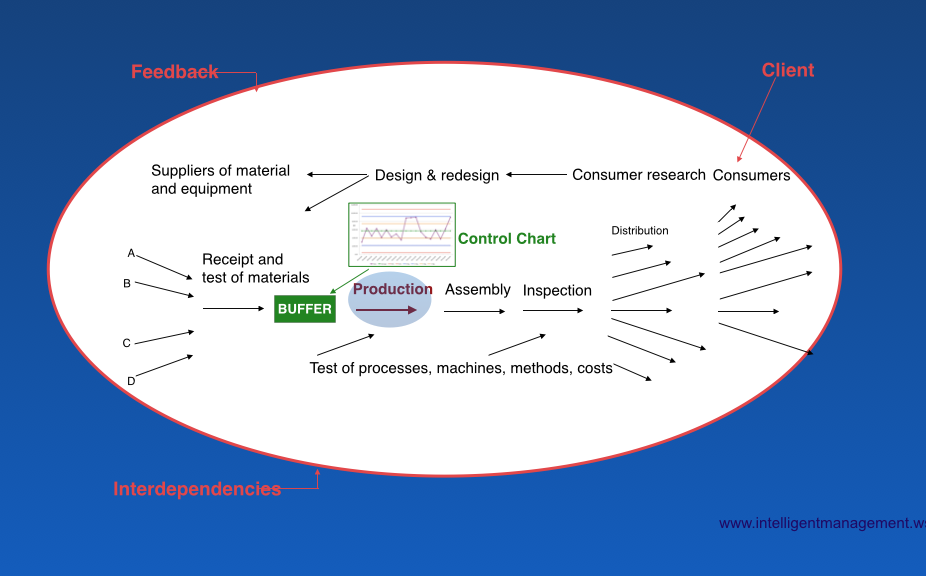
There are those who seek to divide and separate, close borders, thinking that this is a better way to “compete”. Instead, the way we manage, produce, buy and sell can bring people closer together; it can be a way of mending the world. When we begin to see that the everyday tasks of business are all connected at a deeper level, then we begin to see the power that those actions can have for a much bigger picture. And for that we need a Theory of Everything for Management.
Everything is connected
For decades now people have been hearing about ideas such as the “butterfly effect” where the notion is that small causes can lead to big effects. This is just one evocative example of what we may call non-linear reality. In other words, we have come to understand the world in a radically different way to how we understood it one hundred years ago. Back then, the kind of mechanistic models that came from Newtonian thinking were applied directly to labour and production. Everything could be safely divided up into separate boxes and commanded from on high through a vertical hierarchy. That is why organizations were created with levels of command and control and separate departments. They even had to adapt accounting methods to report on this box-like “reality”.
Complexity and networks
Today, instead, science has been telling us for some time that reality is non-linear and that we need to understand new models based on complexity and that means understanding interdependencies and networks. So what does that mean for business? We need only look at the global crises we have been living through to see that a huge shift is happening and that many failures are due to a lack of understanding of how reality actually works today. It is no longer adequate or appropriate to divide organizations up into functions/silos that have difficulty talking to each other and that squabble over budgets. Not only do we need to see organizations as whole systems, we need to work with whole supply chains, and beyond that, to how organizations impact all their stakeholders and their environments. Digital Transformation is pushing in this direction and companies that do not understand how to re-shape their organization and activities for flow are failing. Management needs a reboot.
From what to how
Intelligent Management was founded by a physicist, somebody accustomed to asking fundamental questions about the nature of things and with a keen ability to spot fads, trends and bogus management practices. We started out basing our transformational work with organizations on the whole system understanding of American physicist W. Edwards Deming. We have continued to refine our approach over the years, embracing the Theory of Constraints and researching into how complexity and network theory could contribute to to produce a systemic understanding and method for modern management. This has been our field of practice for over 20 years.
We were invited by CRC Press, New York, to write a book about management aimed at leaders, top executives and forward thinkers. In ‘Quality, Involvement, Flow: The Systemic Organization’ we describe a Theory of Everything for Management based on the work of W. Edwards Deming and the Theory of Constraints. These combined bodies of knowledge provide the philosophy, method and tools for managing in our age of complexity. We explain organizations at their most fundamental level, how to see them as systems and how to organize work as a flow through a pattern of all designed interdependencies to satisfy a common goal. When we talk about work in any organization, essentially we are talking about processes and projects. We describe an effective way to design those processes and manage projects successfully in a systemic way with Critical Chain Project Management.
Hearts and minds
Change is a challenging process and we dedicate an entire chapter to it. We need to understand the human needs and the cognitive leap it takes to work in an organization fit for the 21st century, with no artificial barriers and that engenders the desire to continuously improve and innovate. Working in a systemic organization means constantly working on the cognitive challenges, overcoming conflicts as they arise and strengthening the emotional intelligence required to live with uncertainty. We provide details on the Thinking Process Tools from the Theory of Constraints that provide the support for the new skills – cognitive, creative, emotional and logical – needed to keep pace with rapidly evolving markets.
We show how change can be also highly positive for those who work systemically, eradicating unnecessary barriers and tasks, creating opportunities for real empowerment and self-development, and finding more unity between who we are as people and what we do on a day to day basis. Thinking and acting systemically means having a practical way to overcome the zero-sum game that keeps business stuck in the win-lose mindset that has caused so much havoc in the markets and can only lead to more polarization. Working systemically is all about finding win-win solutions upon which we can build sustainable prosperity, for ourselves, our customers, our suppliers and all the stakeholders.
Business schools need to catch up
Executive heads are rolling for not knowing how to cope in our new digital era. In spite of all the shifts happening, including the digital challenge in particular, most business schools continue to teach pretty much the same things as 50 years ago with a few new programmes added on. We dedicate a whole section of our new book to outline a programme for business schools that is up to date for our era of complexity, from strategy to accounting.
It’s time to start doing only those things that make sense, for ourselves, for our businesses and for the environment.
Intelligent Management, founded by Dr. Domenico Lepore, specializes in Whole System Transformation, based on the systemic management principles of W. Edwards Deming and the Theory of Constraints. We are trusted advisors to leaders of organizations through our unique, whole system Network of Projects organization design. Sign up to our blog here. Intelligent Management provides education and training internationally on systemic management using the Decalogue methodology .
See our new books The Human Constraint – a business novel that has sold in 28 countries so far and ‘Quality, Involvement, Flow: The Systemic Organization’ from CRC Press, New York, by Dr. Domenico Lepore, Dr. .Angela Montgomery and Dr. Giovanni Siepe.






Leave a Reply